
views
X
Trustworthy Source
Centers for Disease Control and Prevention
Main public health institute for the US, run by the Dept. of Health and Human Services
Go to source
Research suggests that washing your hands before handling your contacts and cleaning your contacts with an approved solution can help keep your eyes healthy.[2]
X
Research source
While putting on contacts can be tricky at first, it should become easier over time.
Picking a Type of Contact Lens
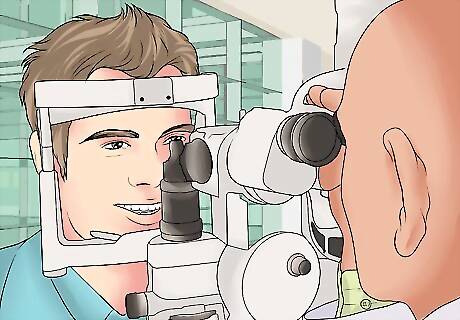
Get an eye exam. If you are interested in wearing contact lenses, get a thorough eye exam to determine exactly what type of corrective lenses you need. Contact lenses can correct: Myopia. People who are myopic can see well close up, but objects far away are blurry. Hyperopia. In this condition, people see well at a distance, but objects close to them are blurry. Presbyopia. This condition occurs when people have more trouble seeing close up as they age. It often begins around age 40. Astigmatism. This occurs when the eye is not shaped correctly. It causes blurred vision. Color blindness. Color blindness occurs when people are unable to perceive some colors, or confuse two colors with each other. Red/green color blindness, which means you confuse the colors red and green together, is most common in men.

Determine what type of contacts you want. Some can only be worn in the day, others can only be worn in the night. The eye doctor will measure your eye to make sure you get contacts that fit and are comfortable. Once you know what you need there are several types to choose from: Soft contact lenses. These contacts are flexible and bend to fit your eye. They can correct myopia, hyperopia, astigmatism, presbyopia, or combinations of these conditions. They are good for people who play sports and are active. Hard contact lenses. These lenses may provide a better image than soft lenses and can be used for most eye conditions. They also have a lower risk of eye infections because they are gas permeable. This means that your eye can breathe through them. If you keep them clean, they can sometimes be used for up to three years; however, some people find them uncomfortable. Hybrid contacts. These contacts have a hard center and soft outer part. They are particularly good for people with keratoconus, or irregularly curved corneas.
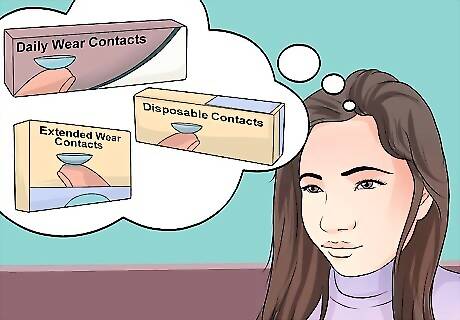
Evaluate what works best with your lifestyle and budget. Hard contacts have the advantage that you can continue using the same pair for up to three years if your prescription stays the same; however, some people find soft contacts more comfortable. If you choose soft contact lenses, there are several types you can choose depending on your lifestyle and budget. Daily wear contacts: These are usually the cheapest option, but they require more care. You have to take them out each night and clean them. Daily wear disposable contacts: These are worn for one day only, then thrown out. Extended wear contacts: These contacts can be left in overnight for up to a week. This option is good for people who are too busy or can’t remember to take them out each night; however, they are not good for people who are prone to eye infections or allergies. Some brands may even be approved to wear continuously for 30 days. Disposable contacts: These contacts require the least effort to wear. These are worn daily (so they must be removed at night) and are good for a certain period, from weeks to months, depending on the type you have. This makes them more expensive.
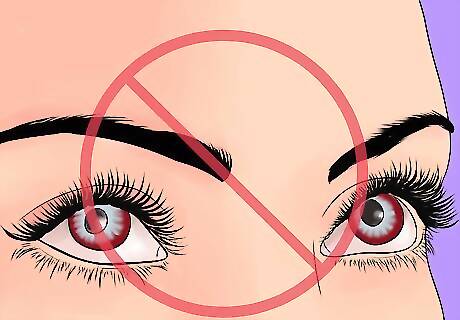
Don’t wear costume contact lenses. While contacts that change your eye color or pupil shape may be fun, they can harm your eyes. If you want colored lenses, optometrist can give a valid Rx for cosmetic contact lenses that are safe to use on a limited basis under the direction of an eye doctor. Contact lenses are medical devices that are quality controlled by the Food and Drug Administration (FDA). In order for contacts to fit you properly and safely, your eye must first be measured by an eye doctor. Stores that sell costume contacts without prescriptions are doing so illegally. Improperly fitting contacts can scratch the surface of your eye, cause infections, and even in severe cases, blindness. Do not buy non-prescription contacts from street vendors, Halloween shops, beauty salons, convenience stores, or online vendors that do not require prescriptions.
Wearing Your Contacts
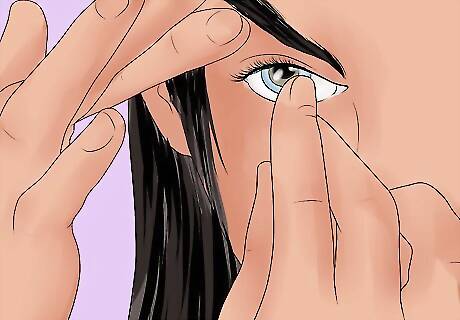
Insert your contacts safely. It may take some practice, but after a few days, you will be able to do it quickly and easily. Follow these steps: Wash and dry your hands. This will make sure you don't transfer dirt or bacteria into your eye, which can cause an infection. Put the contact lens on the tip of your index finger with the concave, cup side facing up. While looking in the mirror, use your middle finger to pull down your lower eyelid and lashes. Place the contact onto the surface of your eye. The bottom edge of the contact should be the first part to touch your eye. It should do so on the white part of your eye just above where you have pulled your lower lid down. Press the contact onto the surface of your eye until you feel it stick. When you take your finger away, the contact should float on the surface of your eye. Blink to adjust it to the correct position. If you are inserting your contacts for the first time, your doctor may suggest that you wear them for only an hour the first day and then wear them for longer periods of time. This will give your eyes a chance to get used to them.
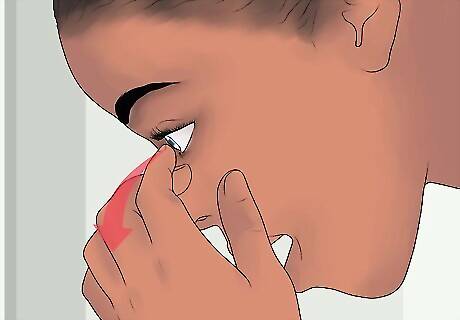
Remove your contacts quickly and easily. Removing your contacts is important because it gives your eye a chance to breathe. Some contacts should be removed every night. To remove your contacts: Wash and dry your hands. Use your middle finger to pull your lower eyelid down. Gently pinch the lens off the surface of your eye using your index finger and thumb. This should not hurt; however, while you are learning, it might be best to keep your fingernails trimmed. This will prevent you from hurting yourself or accidentally tearing the lens. For some lenses, you can use a plunger (DMV), which makes it much easier to take out your contacts: just take the plunger, stick it onto the contacts, and remove them. Ask the provider of your contacts if they have one that you can have or buy.
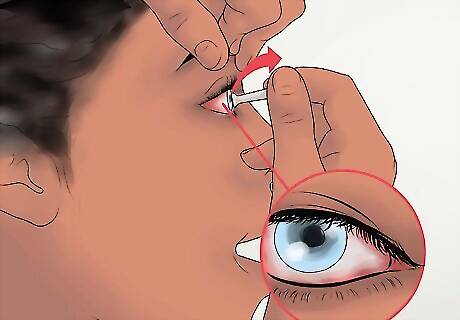
Take out your contacts if you have an eye injury or infection. An injury or infection requires immediate care. Have someone drive you to an emergency room. Do not drive yourself. Get care immediately if you experience: Pain Sudden vision problems like blurring or dark patches in your field of vision Sensitivity to light Bleeding or discharge from the eye Swelling or extreme itching of the eye and eyelids. Throw out any contacts you were wearing during the infection to prevent re-infecting yourself later.
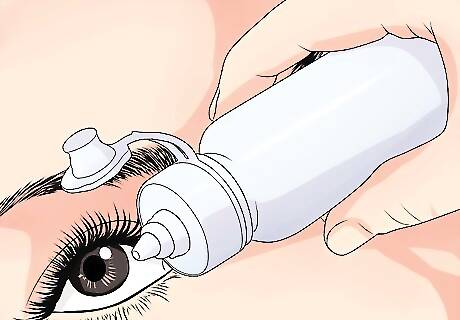
Avoid dry eye by using lubricants. Dry eye happens when your eyes don’t produce enough tears. It can be scratchy, itchy, sting, or burn. Your eyes may also look red. There are several over-the-counter products that may provide relief: Contact lens re-wetting drops or preservative-free artificial tears. Contact lens re-wetting drops that have preservatives are OK to use, but avoid using artificial tears that have preservatives since they can lead to build up on your lenses and cause irritation. Eye ointments. Ointments are thicker than eye drops and may interfere with your vision. Because of this, don’t use them at times when you need to drive or read. Many people use them before bed. If eye drops and eye ointments don’t help your dry eyes, ask your eye doctor about special contacts that can help prevent dry eye. They are called scleral lenses and they don't absorb moisture like softer contact lenses do, making them a good option if you suffer from dry eyes.
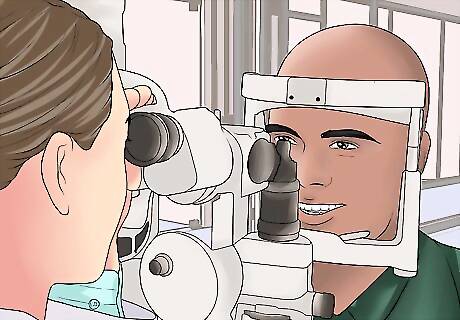
Get regular eye exams. Your eye doctor may want you to do several follow up exams to make sure that your contacts are the right fit for you. You might need a check up after the first week, month, or half year. Afterwards, your doctor will probably recommend an appointment once a year to make sure your prescription hasn’t changed.
Caring for Your Contacts
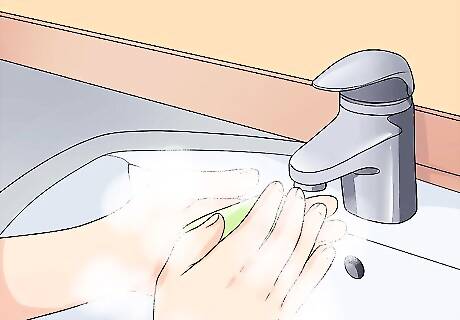
Wash your hands. Don’t touch your contacts with unclean hands. If you do, you are transferring dirt and bacteria into your eyes. Before handling your contacts you should: Wash your hands with soap to remove oils, dirt and bacteria. If you transfer these to your contacts, it could cause an eye infection. Rinse your hands thoroughly. If you get soap in your contacts it will sting when you put your contacts in. Dry your hands with a clean towel. Tap water hasn’t been sterilized so you don’t want to transfer it to your contacts and then to your eye.
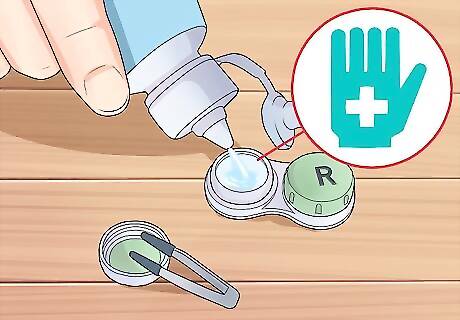
Use a sterile, commercially prepared contact solution. This will be sterilized to prevent eye infections and chemically balanced to match the chemistry of your eye. This makes it both safer, better for your contacts, and less likely to sting. They are available at local drug stores and grocery stores. Ask your eye doctor if there is a particular one that she recommends for your type of lenses. Do not use a homemade saline solution. It isn’t sterilized, won’t have the right concentration of salt, and may have other traces of minerals or chemicals. This could cause eye infections or damage the lenses. Do not use bottled or tap water. Even purified water is not sufficiently sterile. In addition, it will probably sting because it won’t have the correct salt concentration. Do not use saliva. Saliva contains bacteria, enzymes, and many other contaminants which could increase your risk of an eye infection or damage the lenses. Do not top up the contact lens solution when you soak or store your contacts. Change the solution instead to prevent the buildup of bacteria. Do not use expired contact solution. If your contact solution has expired, throw it out and get new solution. It isn’t worth risking an eye infection.
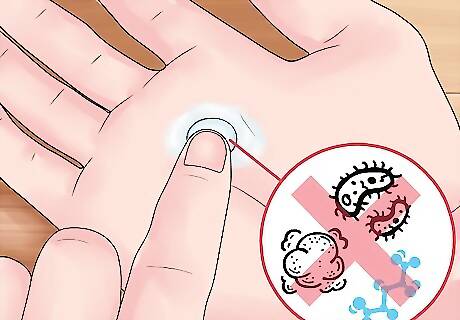
Rub the contacts to remove dirt, bacteria and proteins. Put the contact in the palm of your hand and rinse it with contact solution while using your index finger to rub it. This will remove proteins, bacteria and dust that might have collected on it as you wore it. Keep your fingernails filed to prevent them from piercing and tearing the lens. If you do have long nails, you can use certain techniques to safely remove your contacts. It is best to rub them, even if you have a “no-rub” solution. Do this as often as your type of lenses require. Follow the manufacturer's instructions on the lenses and contact solution, in addition to any recommendations from your doctor.


















Comments
0 comment